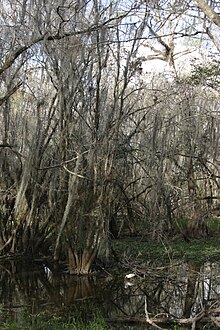| This article needs additional citations for verification. Please help improve this article by adding citations to reliable sources. Unsourced material may be challenged and removed. Find sources: "Florida swamps" – news · newspapers · books · scholar · JSTOR (May 2015) (Learn how and when to remove this message) |




Florida swamps include a variety of wetland habitats. Because of its high water table, substantial rainfall, and often flat geography, the U.S. state of Florida has a proliferation of swamp areas, some of them unique to the state.
Swamp types in Florida include:
- Cypress dome - most common swamp habitat in Florida
- Strand swamp
- Floodplain swamp
- Titi swamp
- Tupelo gum swamp
- Mangrove swamp
Notable swamps
- Green Swamp (Florida) (including the Green Swamp Wilderness Preserve), Polk County
- Everglades
- Corkscrew Swamp Sanctuary in southwest Florida north of Naples, Florida
- Okefenokee Swamp, straddling the Georgia–Florida border
- Barley Barber Swamp
- Santa Fe Swamp
Animal species
Rare animals inhabiting swamps include:
- the Florida panther, an endangered subspecies of cougar (Puma concolor).
- the American alligator
Plant species
Some of the species found in the various types of swamps include:
- Cypress
- bald cypress (Taxodium distichum)
- pond cypress (Taxodium ascendens)
- red mangrove (Rhizophora mangle)
- Palms
- cabbage palm (Sabal palmetto)
- Florida royal palm (Roystonea regia)
- sawgrass (Cladium jamaicense)
- Spanish moss (Tillandsia usneoides)
References
- "Swamp Life: Learning the Florida Swamp Ecosystem". www.theblackhammock.com. Retrieved 2023-05-12.
- "Freshwater Swamps". SFRC Extension. University of Florida. Archived from the original on 2012-08-05. Retrieved 2012-05-21.